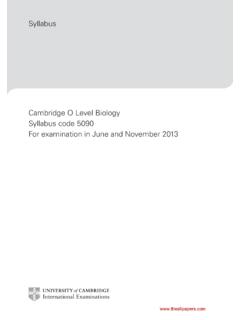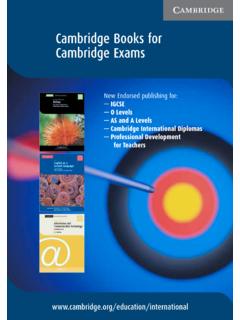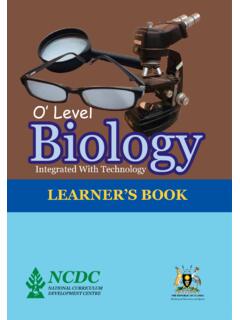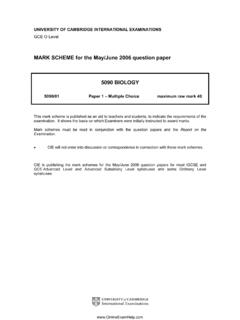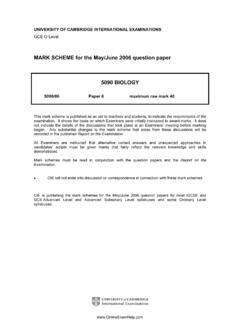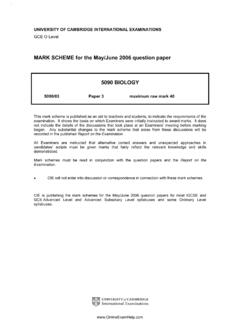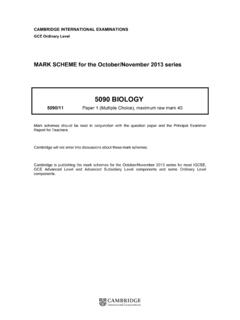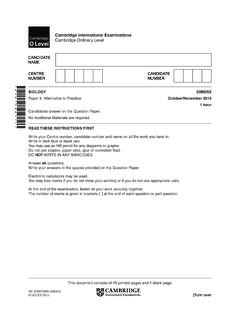Transcription of Class: 9 Sept. ’14 – May ’15 Cambridge O-Level Biology (5090)
1 The City School Curriculum Distribution Chart Class: 9 Sept. 14 May 15 Cambridge O-Level Biology (5090) Unit 1: Cells and cell processes Recommended prior knowledge Since this is a logical place to begin the course, no prior knowledge is essential. Nevertheless, it would be helpful if learners were already familiar with the use of a microscope and with standard, safe laboratory technique. They might also know the basic principles of diagram drawing sharp HB pencil, drawings as large as can be fitted into the available space (with room for labels, in upper case, in pencil with ruled label lines).
2 A simple understanding of chemical molecules and chemical reactions, the kinetic theory, solutions and pH would also be helpful. Context Cells are the building blocks of living organisms and basic physiological processes in which they are involved have relevance throughout the syllabus. Outline Structural features common to and different in plant and animal cells are considered. Specific examples show how the basic cell structure may be modified for different functions. The involvement of cells in the processes of diffusion, osmosis and active transport is explained as is the importance and mode of action of enzymes.
3 Learning objectives Suggested teaching activities Learning resources Week 5090 past question papers are available at: 1 1(a) Candidates should be able to: Examine under the microscope an animal cell ( from fresh liver) and a plant cell ( from Elodea, moss, onion epidermis, or any suitable, locally available material), using an appropriate temporary staining technique, such as iodine or methylene blue Use pre-prepared microscope slides to examine, compare and identify structures in (i) epidermal cells peeled from the inner surface of an onion bulb and stained with iodine solution; (ii) locally available plants with leaves which display mesophyll cells adhering to the peeled-off epidermis in order to show the presence of chloroplasts.
4 (iii) freshwater filamentous algae, Elodea or moss that can be mounted in a drop of water on a slide and viewed under a microscope. A more challenging activity is for learners to prepare their own slides of the type described above and to prepare slides of fresh liver cells or human cheek cells stained with methylene blue. Ask learners to compare the structures seen in each of the slides they have prepared. PowerPoint presentation: Cells and tissues Plant and animal cell structure diagrams and explanations: Illustrations of cells: Cell structure: Video clip cell structure: Textbooks: Jones, M Unit 1 Cell structure Burton, I J Topic 1 Cell structure and organisation 1(b) Draw diagrams to represent observations of the plant and animal cells examined above 1(c) Identify from fresh preparations or on diagrams or photomicrographs, the cell membrane, nucleus and cytoplasm in an animal cell Use slides prepared during practical work above to identify the structures visible.
5 Present learners with diagrams and photomicrographs of a range of cell types to allow them to identify the named structures. A more challenging activity is to use diagrams and photomicrographs Learning objectives Suggested teaching activities Learning resources Week showing these structures within different types of cells with which learners are unfamiliar. Jones, G & Jones, M 1 Cells 2 1(d) Identify from diagrams or photomicrographs, the cellulose cell wall, cell membrane, sap vacuole, cytoplasm, nucleus and chloroplasts in a plant cell Use slides prepared during practical work above to identify the structures visible.
6 Present learners with diagrams and photomicrographs of a range of cell types to allow them to identify the same structures (and those previously not visible). A more challenging activity is to use diagrams and photomicrographs showing these structures within different types of cells with which learners are unfamiliar. 1(e) Compare the visible differences in structure of the animal and the plant cells examined Use the slides prepared and diagrams presented above to construct a table of the similarities and differences between plant and animal cell structure. A more challenging activity is for learners to make models of a plant cell and/or an animal cell to gain an idea of the orientation of the main structures.
7 Extend the task by asking learners to consider the limitations of their models in comparison to actual cellular components. 1(f) State the function of the cell membrane in controlling the passage of substances into and out of the cell Explain why the passage of substances must be controlled. Extend the discussion by inviting learners to suggest chemicals that might pass in either direction through the membrane (and some that may not pass through). Extend further by asking learners to suggest reasons why such substances may/may not enter the cell reasons that they are needed within the cell or because they might harm the cell.
8 5090 5090 past paper question: Jun 2011 Paper 21 Q8 1(h) State, in simple terms, the relationship between cell function and cell structure for the following: absorption root hair cells conduction and support xylem vessels transport of oxygen red blood cells Provide good diagrams of a root hair cell and of a red blood cell (in surface view and in longitudinal section) for learners to label. Alternatively learners may draw and label one of the specialised cells on A3 paper and present their findings to other learners. A more challenging activity is for learners to research a greater range of specialised cells and their functions.
9 Explain the importance of surface area to volume ratios and relate this to the maximum rate and amount of uptake in cells marked*. Understand that xylem vessels are dead and should not be called cells . Their walls are strengthened for support. Since they have no cytoplasm, they are hollow tubes for the conduction of water and mineral ions. Red blood cells are Adaptations of specialised cells: Red blood cell diagram: Root hair cell diagram: 3 Learning objectives Suggested teaching activities Learning resources Week biconcave discs to provide a large surface area for gas exchange and to make the cell flexible enough to pass through small capillaries.
10 4 1(i) Identify these cells from preserved material under the microscope, from diagrams and from photomicrographs Observe prepared slides of root hair cells, xylem vessels and red blood cells under the microscope. Extend this practical work by asking learners to make annotated drawings of a root hair cell and of red blood cells as seen under the microscope. A more challenging practical task is for learners to germinate their own seeds (part-fill a specimen tube or glass jar with water and trap a seed between the walls of the tube/jar and a piece of filter paper) and observe the root hairs. Seed germination apparatus: 1(j) Differentiate cell, tissue, organ and organ system as illustrated by examples covered in syllabus sections 1 12, 15 and 16 Explain the hierarchy of these structures and invite learners to supply both animal and plant examples of each.

